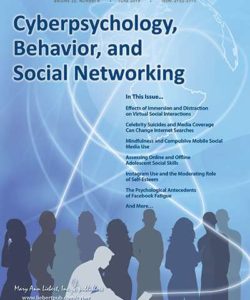Stanford Research Study – Does greater immersion in virtual reality lead to a better experience?
 "The Effects of Immersion and Real-World Distractions on Virtual Social Interactions" was coauthored by Jeremy Bailenson, Catherine Oh, and Fernanda Herrera, Stanford University, CA. The researchers designed a study in which participants interacted with a virtual agent in either an immersive or non-immersive virtual environment with three levels of real-world distractions: no distractions; passive exposure to the sound of a ringing cell phone; actively answering a ringing cell phone. Whereas increased immersion had a positive effect on feeling present in the virtual reality interaction, it had a negative effect on recognition and recall.
"The Effects of Immersion and Real-World Distractions on Virtual Social Interactions" was coauthored by Jeremy Bailenson, Catherine Oh, and Fernanda Herrera, Stanford University, CA. The researchers designed a study in which participants interacted with a virtual agent in either an immersive or non-immersive virtual environment with three levels of real-world distractions: no distractions; passive exposure to the sound of a ringing cell phone; actively answering a ringing cell phone. Whereas increased immersion had a positive effect on feeling present in the virtual reality interaction, it had a negative effect on recognition and recall.
"This very important study highlights again the critical need to understand the role of realism during the VR experience. The clarity of the latest PlayStation characters, for example, or those seen in recently released movies and video clips begs the question of whether the uncanny valley has been overcome," says Editor-in-Chief Brenda K. Wiederhold, Ph.D., MBA, BCB, BCN, Interactive Media Institute, San Diego, California and Virtual Reality Medical Institute, Brussels, Belgium. "Despite over 20 years of research, we still do not fully understand how levels of realism can differentially affect human perception and the underlying psychological milieu. Many VR clinicians have shown that in certain cases, less granular or admittedly more cartoonish avatars and graphics produce better clinical outcomes. On the other hand, in certain types of surgical training, realistic VR is both justified and necessary. There remain many unanswered issues and a lack of good objective measures for our feeling of presence, and this paper plays a crucial role in furthering our knowledge."
See the full story here: https://phys.org/news/2019-06-greater-immersion-virtual-reality.html
Pages
- About Philip Lelyveld
- Mark and Addie Lelyveld Biographies
- Presentations and articles
- Tufts Alumni Bio